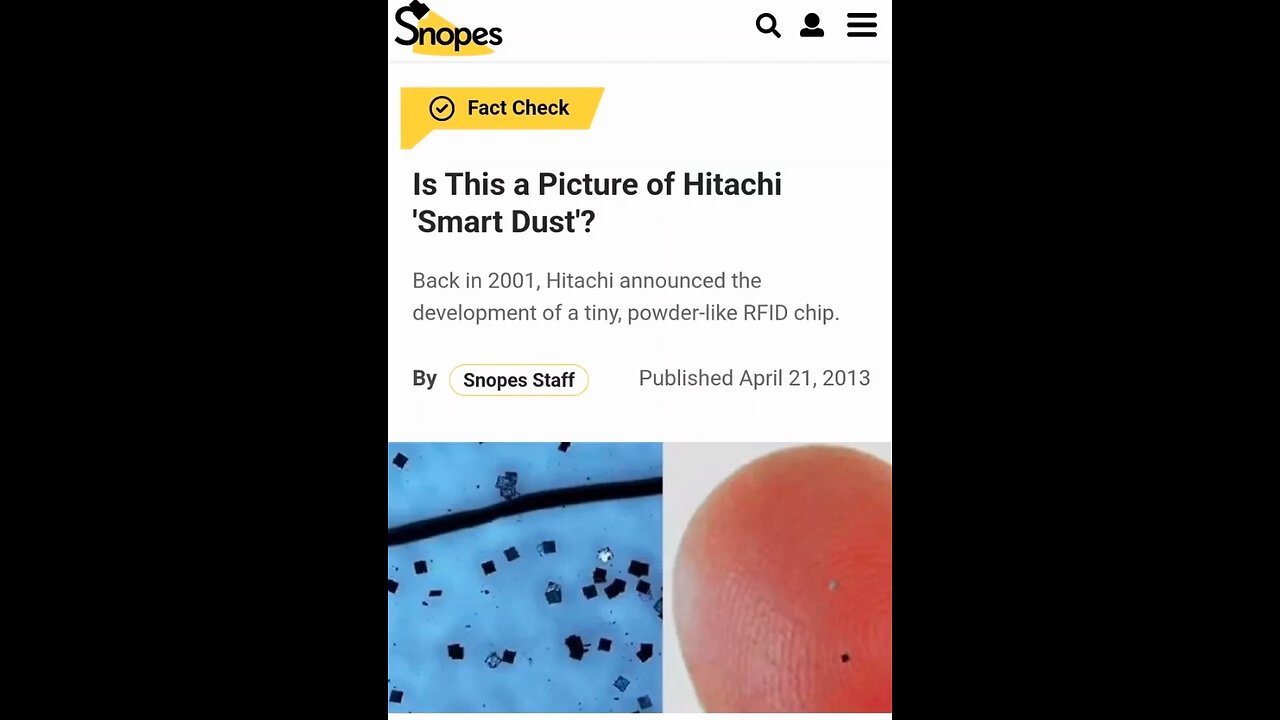Premium Only Content

Hitachi Smart Dust Nanotechnology: The Invisible Revolution in Data and Surveillance
Abstract
Hitachi’s development of smart dust nanotechnology represents a groundbreaking advancement in microelectronics and nanotechnology, with profound implications for industries ranging from healthcare to defense. These microscopic devices—smaller than grains of sand—are capable of sensing, computing, and transmitting data, enabling unprecedented levels of connectivity and surveillance. While the technology holds transformative potential, its ethical and societal implications demand careful examination. This article explores the science behind Hitachi smart dust, its current and future applications, and the challenges it poses to privacy, security, and human autonomy.
Introduction
Imagine a future where the air around you is teeming with microscopic sensors, gathering data on your movements, health, and environment without your awareness. Hitachi’s smart dust technology, leveraging the power of nanotechnology, is making this vision a reality. Originally developed as “RFID powder,” these nanodevices are designed to operate as ultra-small sensors, capable of embedding themselves in everyday objects and even within living organisms.
While the technology offers revolutionary applications in medicine, industry, and environmental monitoring, it also raises profound questions about its potential misuse for surveillance and control. This article delves into the workings of Hitachi’s smart dust and its implications for the future.
What is Hitachi Smart Dust?
1. Technical Overview
Hitachi smart dust consists of micro-electromechanical systems (MEMS) that combine sensing, processing, and communication capabilities. Measuring only a few micrometers in size, these devices can be dispersed like dust into virtually any environment.
Key components include:
• Sensors: Capable of detecting light, temperature, humidity, pressure, and more.
• Communication Modules: Typically using RFID or Bluetooth for data transmission.
• Power Sources: Microbatteries or energy harvesting mechanisms like vibration or solar energy.
2. Origins and Development
Hitachi’s innovation in smart dust began with its development of RFID (radio frequency identification) tags in the early 2000s. The evolution into RFID powder marked a leap forward, shrinking these systems to microscopic scales while maintaining their functionality.
3. Integration with IoT
Smart dust acts as a cornerstone for the Internet of Things (IoT), enabling seamless communication between devices and systems on an unprecedented scale.
Applications of Hitachi Smart Dust
1. Healthcare and Medicine
• Internal Diagnostics: Smart dust can be ingested or injected into the body, where it collects real-time data on vital signs, hormone levels, and disease markers.
• Drug Delivery Systems: These nanodevices can release medication at precise locations and intervals, reducing side effects and improving efficacy.
• Remote Monitoring: Physicians can monitor patients continuously without invasive procedures.
2. Environmental Monitoring
• Climate Data Collection: Distributed across forests or oceans, smart dust can gather critical data on climate change.
• Pollution Detection: Sensors embedded in urban areas can detect air quality issues, water contamination, and toxic spills.
3. Industrial Optimization
• Predictive Maintenance: Machines equipped with smart dust can report wear-and-tear conditions in real-time, preventing breakdowns.
• Supply Chain Monitoring: From tracking shipments to verifying authenticity, smart dust provides unparalleled transparency.
4. Defense and Surveillance
• Stealth Reconnaissance: Smart dust can monitor troop movements, detect intrusions, and provide battlefield intelligence.
• Urban Surveillance: Nanodevices can be deployed in public spaces to monitor activities discreetly.
5. Smart Cities
• Traffic Management: Sensors embedded in roads can optimize traffic flow and monitor vehicle conditions.
• Infrastructure Health: Bridges, buildings, and pipelines can be monitored for structural integrity without human intervention.
Challenges and Ethical Implications
1. Privacy Concerns
The ability of smart dust to operate invisibly raises alarms about mass surveillance. Unlike traditional cameras or sensors, these devices are virtually undetectable, creating potential for misuse by governments, corporations, or malicious actors.
Questions to consider:
• How can individuals consent to monitoring if the devices are invisible?
• What safeguards can be implemented to prevent abuse?
2. Data Security
• Hacking Risks: Smart dust relies on wireless communication, making it vulnerable to cyberattacks.
• Data Ownership: Who owns the data collected by smart dust systems—individuals, companies, or governments?
3. Health and Safety
• Biocompatibility: While promising in healthcare, concerns remain about the long-term effects of introducing these particles into the human body.
• Environmental Impact: Large-scale deployment could pose ecological risks if the devices accumulate or interfere with ecosystems.
4. Ethical Governance
• Should there be international treaties regulating the use of smart dust?
• How can transparency be enforced when the technology’s very nature is to remain invisible?
The Future of Smart Dust
1. Advances in Capabilities
As nanotechnology progresses, smart dust is likely to become even smaller, more efficient, and capable of performing complex tasks autonomously. AI integration could allow these devices to process data locally, reducing dependency on external networks.
2. Ubiquity in Daily Life
• By 2030, smart dust could be embedded in every facet of modern life, from clothing to household appliances, creating a world where connectivity is seamless and omnipresent.
• Smart dust could render traditional electronics obsolete, replacing visible devices with imperceptible networks.
3. Human Enhancement
• Smart dust may pave the way for human augmentation, enabling people to access real-time health data, enhance senses, or even interface directly with digital systems.
Conclusion
Hitachi’s smart dust nanotechnology represents a double-edged sword. On one hand, it promises transformative benefits in healthcare, industry, and environmental management. On the other hand, its potential for misuse poses serious ethical, privacy, and security challenges.
As this technology advances, it is crucial to establish safeguards that balance innovation with individual rights and societal well-being. The rise of smart dust is not just a technological milestone—it is a test of humanity’s ability to responsibly wield tools that shape the future.
The question remains: will we harness this invisible revolution for the greater good, or will it become yet another mechanism of control in an increasingly surveilled world? The answer lies in how we choose to integrate transparency, governance, and ethical oversight into this remarkable innovation.
-
 7:55:51
7:55:51
Dr Disrespect
21 hours ago🔴LIVE - DR DISRESPECT - WARZONE - SHOTTY BOYS ATTACK
244K33 -
 1:30:23
1:30:23
Twins Pod
20 hours agoHe Went From MARCHING With BLM To Shaking Hands With TRUMP! | Twins Pod - Episode 45 - Amir Odom
154K34 -
 1:02:30
1:02:30
Exploring With Nug
22 hours ago $4.65 earned2 Duck Hunters Missing After Kayak Capsizes!
75.3K5 -
 46:48
46:48
Mally_Mouse
15 hours agoLet's Hang!! -- Opening Christmas gifts from YOU!
81.4K1 -
 44:55
44:55
Athlete & Artist Show
20 days ago $2.46 earnedNHL 4 Nations Snubs, Was Hawk Tuah Coin A Scam?
76.6K -
 33:47
33:47
Stephen Gardner
21 hours ago🔥Pentagon Whistleblower UNLEASHES on Biden and Obama!
132K294 -
 2:20:30
2:20:30
The Dilley Show
22 hours ago $29.28 earnedRoger Stone in Studio plus Q&A Friday! w/Author Brenden Dilley 12/27/2024
107K28 -
 1:57:02
1:57:02
The Charlie Kirk Show
20 hours agoThe Great H-1B Battle + AMA | Lomez | 12.27.24
195K301 -
 11:39
11:39
Russell Brand
1 day agoWhat You're Not Being Told About The Syrian War
188K304 -
 DVR
DVR
Bannons War Room
1 year agoWarRoom Live
101M